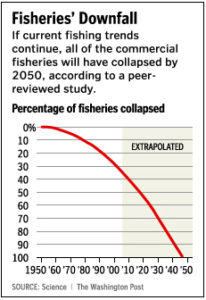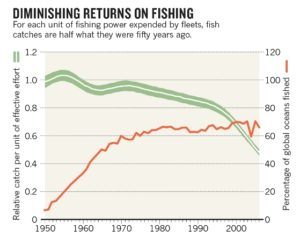Fishing for Fish Data: Digitizing Aquaculture

Hawaii’s Kampachi Farms wants to revolutionize fish farming with digital technology.
Seafood Supply Chain Risk
Do you know how your fish is produced? In 2016, the AP published an investigative report on how seafood produced with slave labor in Indonesia ended up in the U.S. [1]. Because of this investigation, P&G, Nestle, Purina, Costco, and other companies were slapped with class-action lawsuits [2]. Retailers must source legal and ethical seafood, all while keeping costs low and quality high. In addition, 67% of U.S. consumers now “want to know that their fish can be traced back to a known and trusted source [3]. High demand for seafood has led to serious overfishing. If the current situation does not change, some scientists predict populations of fish species we currently consume will collapse in 30 years [4]. Kampachi Farms aims to change that by using digital technology such as automated feeders, ocean current mapping, sensors, and GPS tracking to ethically farm better quality fish at lower costs and with less environmental impact [5].


Traditional Ocean Fish Sources
Ocean fish generally come from commercial fisheries or fish farms. As wild fish stocks became depleted, aquaculture’s popularity grew. For many species now produced through aquaculture, farmed production is substantially higher than the highest catch ever recorded [6]. However, the crowded and dirty conditions of many fish farms cause disease to spread quickly from one pen to the next and create pollution from high concentrations of fish waste. Farmers combat this with heavy use of antibiotics. Fish farming operations are located close to shore for easier access when feeding, monitoring, and harvesting fish. These waters are also gentler on equipment compared to the open ocean [7]. Rapid growth in ocean aquaculture, heavy antibiotics use, and pollution have caused environmental damage to sensitive marine habitats and raised questions about the sustainability of aquaculture [8]. Without an alternative approach to producing fish, quality will decrease and costs will rise as demand far outstrips supply.
Kampachi uses digital technology to tackle some of the issues around aquaculture and help increase supply. As technology advances, Kampachi seeks to innovate new ways to reduce the cost to produce fish. By creating more sustainable production methods, Kampachi can also help ensure fish stocks remain stable, keeping long term costs of fish down. How will Kampachi accomplish this?
Remote Farming
Kampachi is exploring the use of sensors, automated devices, and digital connectivity to remotely monitor and feed its fish populations [9]. This enables Kampachi to increase productivity (quantity of fish produced per employee). Why does this matter? North American fishery and fish farm employees are only 31% more productive than their Latin American counterparts [10]. For Kampachi to produce economically valuable fish, it needs to increase productivity or create high value-add products. With digital technology and automated feeders, Kampachi can increase productivity and reduce total labor costs.
Remote technology also means Kampachi can space pods out and place them offshore in deeper waters with stronger currents. This reduces disease risk and antibiotic costs. As an added benefit, the currents sweep away fish waste and reduce environmental impact on delicate coral reefs around the Big Island [11]. Not only does this help Kampachi’s long-term prospects, it creates additional value. Consumers perceive farmed fish to be more available and cheaper but will pay a premium for wild caught fish, which they perceive to be higher quality due to lower use of antibiotics and reduced handling [12]. Open ocean farming falls somewhere in the middle, much like cage-free eggs fall between regular and free-range eggs. Digital technology has enabled Kampachi to innovate a new operating model (open ocean aquaculture) and create value which Kampachi can capture by pricing its fish at a premium relative to traditional farmed fish.

Risks and Additional Steps
Kampachi hopes to develop “drifter” pods that float with ocean currents and can be tracked with satellite communications technology [14]. As of right now, the technology needed to collect ocean current data and analyze it isn’t advanced enough to support a full commercial drifter farm [15]. Kampachi partnered with NOAA and Lockheed Martin to develop these technologies further and created a single point mooring system with commercialization potential [16]. While Kampachi scales this model, some next steps to consider could include:
- Building strong relationships with distributors. Kampachi can more accurately predict its final output compared to fisheries or traditional farms because of its 98% fish survival rates. Armed with this knowledge and complete certainty of ethical production, Kampachi could help the rest of the supply chain manage inventory risk. Stronger customer relationships leads to higher and more reliable revenue.
- Developing this technology for other species with high value, can’t be farmed in shallow waters, or have unreliable yields. Kampachi can command a premium for these types of fish.
- Develop other feed options besides GMO soy, which may cause customer backlash [17].

(800 words)
[1] http://www.ap.org/explore/seafood-from-slaves/more-than-2,000-enslaved-fishermen-rescued-in-6-months.html
[2] Ibid.
[3] http://www.prnewswire.com/news-releases/new-dna-results-answer-consumers-demand-for-trust-in-seafood-300236712.html
[4] Worm, B. et al (2006) Impacts of biodiversity loss on ocean ecosystem services. Science, 314: 787
[5] http://www.kampachifarm.com/
[6] http://www.fao.org/docrep/013/i1820e/i1820e01.pdf
[7] http://www.npr.org/templates/story/story.php?storyId=5291579
[8] http://worldoceanreview.com/en/wor-2/aquaculture/
[9] http://www.kampachifarm.com/
[10] http://www.fao.org/docrep/013/i1820e/i1820e01.pdf
[11] http://www.kampachifarm.com/
[12] https://www.ncbi.nlm.nih.gov/pubmed/24709486
[13] http://www.kampachifarm.com/
[14] Ibid.
[15] Ibid.
[16] Ibid.
[17] http://phys.org/news/2013-06-gmo-corn-soybeans-dominate.html



Wow! At first glance it seems like the fish pods a more humane method of fish farming, but is it really any better than shallow fish farms beyond the free current? If fish are still stuck inside the cage, will future regulation have to specify wild vs farmed living conditions? I think the technology around automatic feeding and monitoring could be a game changer in the industry. It will be interesting to see if any other fish farming companies follow Kampachi, or wait for the technology to be more affordable and available.
This is really interesting. Another thing to think about: are fish bred or do they catch fish and then fatten them? Tuna is traditionally the latter, while other species are often bred. Just because a fish is farmed doesn’t mean it isn’t contributing to overfishing. The same applies to feed. Here, Kampachi is using only GMO soy. But many farmers actually catch small fish to feed to those they are raising. That contributes to overfishing. But other feeds are often disliked by customers and unnatural and often pollute the ocean. A lot of challenges to deal with in the coming years!
This was fascinating, Jina. I’m curious about the relatives costs and potential upside of this technology. Is the price differential between farmed and drifter pod-raised fish large enough to make this project worthwhile for a first-mover? Or, given that Lockheed Martin was a partner, was it developed with potential other applications beyond the fish industry in mind? Do you have any sense of the competition’s response to this–is this popular in the fish market?
Not related to digitization, but out of personal curiosity: you seemed careful to refer only to “perceived” quality differences between farmed and wild-caught fish. As a fish consumer, I know that I feel as though I perceive a difference in taste between the two. Are there any differences in actual nutritional quality between the farmed and wild-caught fish, or has there been any research into other quality differences? Or is this difference something that can be tackled through marketing? Will marketing their fish as “pod-raised” affect consumer preferences for Kampachi’s products?
Great article on a unique company looking at the fisheries business. Their idea for a drifter farm is interesting, but I wonder about the limits of the technology. Technology already exists for the tracking of the pods (or ships or airplanes) across oceans, so is the technological limit based more on geofencing and trying to keep the pods within an acceptable limit? Due to fishing laws having a lot to do with location and ensuring boats are in international waters and not infringing on the fishing rights of individual nations by getting to close to their shores, this would seem a specific threat to a drifting model. There are some new technologies to establish a marine-based geophone that can alert if a boat or other object with the tracker leaves the assigned area [1]. This could be good for keeping the fish within an acceptable habitat, or keeping them within waters where the company can ensure others will not try to harvest their fish. The National Oceanic and Atmospheric Association (NOAA) is concerned with US fisheries and ensuring their practices are both sustainable and economically sound and supported by regulation [2]. They and would likely be in favor of a balanced drifting approach of allowing the pods to go with the oceans, so long as they stay at depths that keep them from being a danger to other vessels and don’t stray into the waters of other nations. Geofencing could go a long way to help with their model.
[1] “Keeping your Boat Inside a Geofence,” Ocean Navigator, http://www.oceannavigator.com/January-February-2011/Keeping-your-boat-inside-a-geofence/, accessed November 20, 2016.
[2] “Guidance for Conducting Economic and Social Analysis for Regulatory Actions,” NOAA, http://www.nmfs.noaa.gov/sfa/laws_policies/economic_social/index.html, accessed November 20, 2016.
It seems like Kampachi has a major marketing need ahead of it: It needs to tell consumers that wild-caught fish are unsustainable, that traditional fish farms have issues, and — crucially — that Kampachi exists in a middle ground that avoids the issues on either side. How difficult will it be for the company to tell that story to consumers? We’ve discussed many times in marketing class how difficult it is to change consumer behavior, and it seems like Kampachi needs to do even more behavior changing than usual: it needs to both make consumers want to educate themselves about where their fish come from and to apply that education to the grocery aisle on a regular basis.
Do you think an aquaculture business like Kampchai is capable of selling that message to consumers?
What an interesting choice, Jina. This post made me think about our other TOM challenge about climate change in that I believe most consumers think that eating seafood rather than mammals reduces their carbon footprint because fishing or fish farming seems like it would be less carbon intensive than beef-farming, for example. That said, the disease risk and heavy equipment use that you point out are real problems of our increased seafood consumption that are ripe for digital solutions.
I also wonder how much digitization can help an industry so dependent on consumer perception? Is, for example, consumers value of wild-caught fish so strong that even farmed fish that might be free from antibiotics, disease, and other negative characteristics is still perceived to be less desirable? Regardless, I’m happy to see that digitization is improving our food supply.
Interesting stuff – I wonder if confining a large population of fish to a floating cage would lead to 1) buildup of fish feces, which in turn could potentially affect the chemical makeup of the surrounding ocean environment and damage the local ecosystem; 2) vulnerability to infectious diseases that could kill off the entire population inside the cages.
Gina, thanks for the glimpse into this new aquaculture innovation — I had no idea that digital drifter pods existed! I admire Kampachi’s vision to leverage digital to overcome issues in fish farming, but I have a few concerns that I hope they are planning to address. 1) The upfront capital required to produce and deploy this technology is significant, and I am wary that they will not be able to recoup the costs through premium pricing in the near term. After all, if consumers are willing to pay a much higher price for digitally-farmed fish over traditionally farmed fish, I think they would opt to buy wild fish. Even if Kampachi is able to invest in educating consumers on the value of digital farming, consumer preferences will be slow to change. 2) Kampachi will face barriers to entry as they expand this initiative from a local experiment to federal waters in other states. Kampachi will need to obtain permits from numerous marine organizations, which will compromise their ability to scale quickly. 3) One of the highest costs for fish farmers is the feed, and I worry that in an open-ocean context, some feed will be lost, which wouldn’t be an issue in typical closed-pen farming. As a result, Kampachi would need to procure more of the expensive feed or invest more in R&D to develop a way to reduce this inefficiency. Overall, I’m excited to see the use of these new technologies and hope they are able to make an impact in our ever-diminishing fish supply.
I know very little about fish farming, and was amazed to learn about these techniques for getting fish to our tables! It is quite astounding to see how consumer demand drives innovation and new solutions using technology. I never would have thought that a floating fish pod would be an economically feasible way to farm fish, but given the reduced supply caused by overfishing and increased demand, I imagine we will see other innovative approaches in the future.
I agree with Anja_A – I can see this industry facing the same tradeoffs/challenges as land farming of animals, particularly regarding ethical treatment of the captive animals and increased consumer education.
Thanks for the informative post.